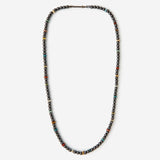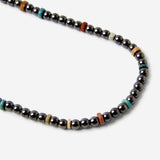FAIENCE NECKLACE WITH HEMATITE
ORIGINAL ANTIQUITY
ANCIENT · EGYPT
We attend all our customers personally. Please leave us your contact details for information and sales.
We attend all our customers personally. Please leave us your contact details for information and sales.
DESCRIPTION
ORIGINAL EGYPTIAN FAIENCE BEADS (1550–1069 BC) · Egyptian faience stands for innovation in accessories for kings, nobles and commons. We individually select beads for colour, size and condition, to be hand-strung on this necklace with hematite beads.
Each necklace is unique
Ruthenium plated silver clasp
Variations in stone and faience colours may occur
Length 51cm/20"

EGYPTIAN FAIENCE BEADS (1550–1069 BC)
Egyptian faience is a sintered-quartz ceramic material from Ancient Egypt. It was widely used for small objects, and is found in both elite and popular contexts. The ancient Egyptians gave faience a wide variety of uses, from tubular blue beads strung together in a net pattern, to coloured necklaces and even beaded masks.
This specific group of coloured beads originally comes from two English and French collections, traced back to Flinders Petrie (1853-1942), a legendary Egyptologist, mentor to Howard Carter.
Coloured faience beads were very popular in ancient Egypt, and were widely used for body jewelry.



-
B. Brier, Egyptian mummies: unraveling the secrets of the ancient art
-
B. Brier, Egyptomania: our three thousand year obsession with the land of the pharaohs
-
P. Remler, Egyptian mythology (chapter about the opening of the mouth ceremony)
Acquired at an antiquities dealer in London, legally exported under the British and European legislation for export of cultural goods. Authenticity has been certified by C.M., member of the British Treasure Valuation Committee and Deputy Chairman of ADA (Antiquities Dealers Association).
This specific group of beads originally traces back to two English and French collections. One comes with an aclaratory note that directly relates to an excavation at Gusob by Flinders Petrie (1853-1942), a legendary Egyptologist, mentor to Howard Carter.






